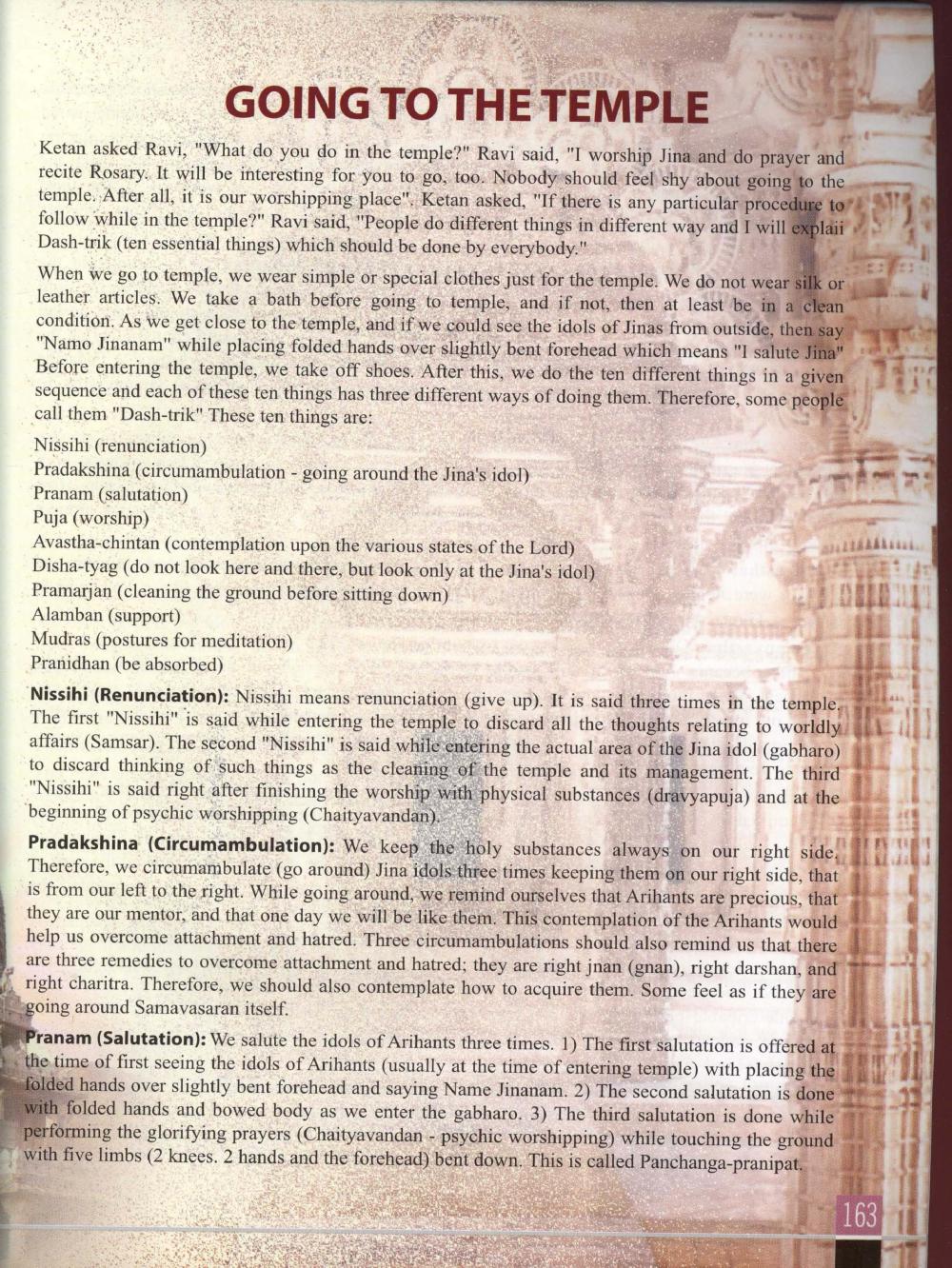________________
GOING TO THE TEMPLE
Ketan asked Ravi, "What do you do in the temple?" Ravi said, "I worship Jina and do prayer and recite Rosary. It will be interesting for you to go, too. Nobody should feel shy about going to the temple. After all, it is our worshipping place". Ketan asked, "If there is any particular procedure to follow while in the temple?" Ravi said, "People do different things in different way and I will explaii Dash-trik (ten essential things) which should be done by everybody." When we go to temple, we wear simple or special clothes just for the temple. We do not wear silk or leather articles. We take a bath before going to temple, and if not, then at least be in a clean condition. As we get close to the temple, and if we could see the idols of Jinas from outside, then say "Namo Jinanam" while placing folded hands over slightly bent forehead which means "I salute Jina" Before entering the temple, we take off shoes. After this, we do the ten different things in a given sequence and each of these ten things has three different ways of doing them. Therefore, some people call them "Dash-trik" These ten things are: Nissihi (renunciation) Pradakshina (circumambulation - going around the Jina's idol) Pranam (salutation) Puja (worship) Avastha-chintan (contemplation upon the various states of the Lord) Disha-tyag (do not look here and there, but look only at the Jina's idol) Pramarjan (cleaning the ground before sitting down) Alamban (support) Mudras (postures for meditation) Pranidhan (be absorbed) Nissihi (Renunciation): Nissihi means renunciation (give up). It is said three times in the temple. The first "Nissihi" is said while entering the temple to discard all the thoughts relating to worldly affairs (Samsar). The second "Nissihi" is said while entering the actual area of the Jina idol (gabharo) to discard thinking of such things as the cleaning of the temple and its management. The third "Nissihi" is said right after finishing the worship with physical substances (dravyapuja) and at the "beginning of psychic worshipping (Chaityavandan). Pradakshina (Circumambulation): We keep the holy substances always on our right side, Therefore, we circumambulate (go around) Jina idols three times keeping them on our right side, that is from our left to the right. While going around, we remind ourselves that Arihants are precious, that they are our mentor, and that one day we will be like them. This contemplation of the Arihants would help us overcome attachment and hatred. Three circumambulations should also remind us that there are three remedies to overcome attachment and hatred; they are right jnan (gnan), right darshan, and right charitra. Therefore, we should also contemplate how to acquire them. Some feel as if they are going around Samavasaran itself. Pranam (Salutation): We salute the idols of Arihants three times. 1) The first salutation is offered at the time of first seeing the idols of Arihants (usually at the time of entering temple) with placing the folded hands over slightly bent forehead and saying Name Jinanam. 2) The second salutation is done with folded hands and bowed body as we enter the gabharo. 3) The third salutation is done while performing the glorifying prayers (Chaityavandan - psychic worshipping) while touching the ground with five limbs (2 knees. 2 hands and the forehead) bent down. This is called Panchanga-pranipat.
163




